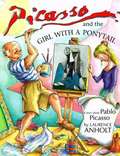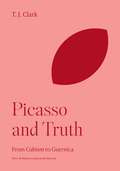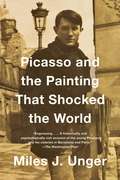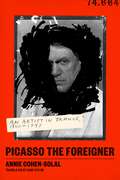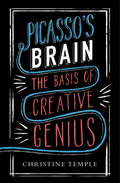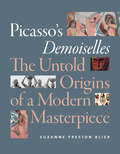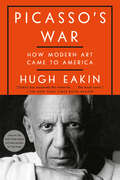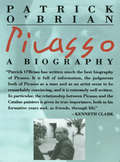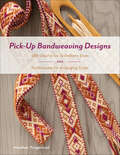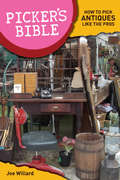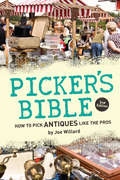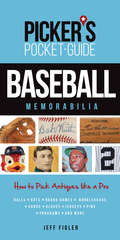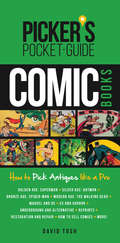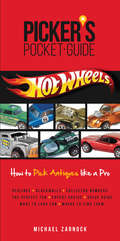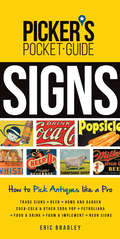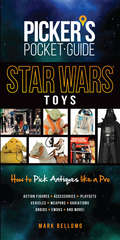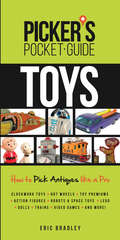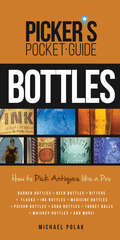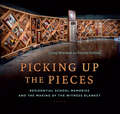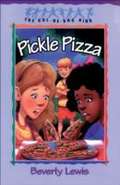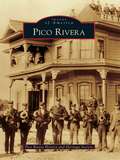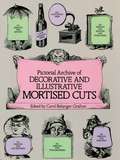- Table View
- List View
Picasso And The Girl With A Ponytail: A Story About Pablo Picasso
by Laurence AnholtHere is the fascinating story -- based on true fact -- of a world-famous artist and a little girl who became one of his models. Sylvette first met Picasso in 1954, when she was a girl in the southern French town of Vallauris.<P><P> At that time, she was the shyest and dreamiest girl among her friends, though today, she is a respected artist in her own right. When Picasso set up his studio in a nearby house, he spotted young Sylvette and was taken immediately by her classical profile and her lovely ponytail. <P> When at last he convinced her to pose for what became the first of more than forty works of art, the two gradually became good friends. Before long, Picasso's portraits of Sylvette became famous around the world.
Picasso and Truth: From Cubism to Guernica (The A. W. Mellon Lectures in the Fine Arts #58)
by T. J. ClarkA groundbreaking reassessment of Picasso by one of today's preeminent art historiansPicasso and Truth offers a breathtaking and original new look at the most significant artist of the modern era. From Pablo Picasso's early The Blue Room to the later Guernica, eminent art historian T. J. Clark offers a striking reassessment of the artist's paintings from the 1920s and 1930s. Why was the space of a room so basic to Picasso's worldview? And what happened to his art when he began to feel that room-space become too confined—too little exposed to the catastrophes of the twentieth century? Clark explores the role of space and the interior, and the battle between intimacy and monstrosity, in Picasso's art. Based on the A. W. Mellon Lectures in the Fine Arts delivered at the National Gallery of Art, this volume remedies the biographical and idolatrous tendencies of most studies on Picasso, reasserting the structure and substance of the artist's work.With compelling insight, Clark focuses on three central works—the large-scale Guitar and Mandolin on a Table (1924), The Three Dancers (1925), and The Painter and His Model (1927)—and explores Picasso's answer to Nietzsche's belief that the age-old commitment to truth was imploding in modern European culture. Masterful in its historical contextualization, Picasso and Truth rescues Picasso from the celebrity culture that trivializes his accomplishments and returns us to the tragic vision of his art—humane and appalling, naïve and difficult, in mourning for a lost nineteenth century, yet utterly exposed to the hell of Europe between the wars.Published in association with the Center for Advanced Study in the Visual Arts, National Gallery of Art, Washington, DCPlease note: All images in this ebook are presented in black and white and have been reduced in size.
Picasso and the Painting That Shocked the World
by Miles J. UngerOne of The Christian Science Monitor&’s Best Nonfiction Books of 2018 &“An engrossing read…a historically and psychologically rich account of the young Picasso and his coteries in Barcelona and Paris&” (The Washington Post) and how he achieved his breakthrough and revolutionized modern art through his masterpiece, Les Demoiselles d&’Avignon.In 1900, eighteen-year-old Pablo Picasso journeyed from Barcelona to Paris, the glittering capital of the art world. For the next several years he endured poverty and neglect before emerging as the leader of a bohemian band of painters, sculptors, and poets. Here he met his first true love and enjoyed his first taste of fame. Decades later Picasso would look back on these years as the happiest of his long life. Recognition came first from the avant-garde, then from daring collectors like Leo and Gertrude Stein. In 1907, Picasso began the vast, disturbing masterpiece known as Les Demoiselles d&’Avignon. Inspired by the painting of Paul Cézanne and the inventions of African and tribal sculpture, Picasso created a work that captured the disorienting experience of modernity itself. The painting proved so shocking that even his friends assumed he&’d gone mad, but over the months and years it exerted an ever greater fascination on the most advanced painters and sculptors, ultimately laying the foundation for the most innovative century in the history of art. In Picasso and the Painting That Shocked the World, Miles J. Unger &“combines the personal story of Picasso&’s early years in Paris—his friendships, his romances, his great ambition, his fears—with the larger story of modernism and the avant-garde&” (The Christian Science Monitor). This is the story of an artistic genius with a singular creative gift. It is &“riveting…This engrossing book chronicles with precision and enthusiasm a painting with lasting impact in today&’s art world&” (Publishers Weekly, starred review), all of it played out against the backdrop of the world&’s most captivating city.
Picasso the Foreigner: An Artist in France, 1900-1973
by Annie Cohen-Solal"Absorbing [and] astute . . . Cohen-Solal captures a facet of Picasso’s character long overlooked." —Hamilton Cain, The Wall Street Journal"A beguiling read, as ingenious as it is ambitious . . . See Picasso and Paris shimmering with new light." —Mark Braude, author of Kiki Man Ray: Art, Love, and Rivalry in 1920s ParisBorn from her probing inquiry into Picasso's odyssey in France, which inspired a museum exhibition of the same name, historian Annie-Cohen Solal’s Picasso the Foreigner presents a bold new understanding of the artist’s career and his relationship with the country he called home.Winner of the 2021 Prix Femina EssaiBefore Picasso became Picasso—the iconic artist now celebrated as one of France’s leading figures—he was constantly surveilled by the police. Amidst political tensions in the spring of 1901, he was flagged as an anarchist by the security services—the first of many entries in what would become an extensive case file. Though he soon became the leader of the cubist avant-garde, and became increasingly wealthy as his reputation grew worldwide, Picasso’s art was largely excluded from public collections in France for the next four decades. The genius who conceived Guernica as a visceral statement against fascism in 1937 was even denied French citizenship three years later, on the eve of the Nazi occupation. In a country where the police and the conservative Académie des Beaux-Arts represented two major pillars of the establishment at the time, Picasso faced a triple stigma—as a foreigner, a political radical, and an avant-garde artist.Picasso the Foreigner approaches the artist’s career and work from an entirely new angle, making extensive use of fascinating and long-understudied archival sources. In this groundbreaking narrative, Picasso emerges as an artist ahead of his time not only aesthetically but politically, one who ignored national modes in favor of contemporary cosmopolitan forms. Cohen-Solal reveals how, in a period encompassing the brutality of World War I, the Nazi occupation, and Cold War rivalries, Picasso strategized and fought to preserve his agency, eventually leaving Paris for good in 1955. He chose the south over the north, the provinces over the capital, and craftspeople over academicians, while simultaneously achieving widespread fame. The artist never became a citizen of France, yet he enriched and dynamized its culture like few other figures in the country’s history. This book, for the first time, explains how.Includes color images
Picasso's Brain: The basis of creative genius
by Christine TempleWhere does creativity come from? Why are some people more creative than others?Eminent neuropsychologist Christine Temple navigates a wide range of factors from the hard science (visual memory, spatial ability, brain functions) to the environmental (the 'mad genius' myth, and Gladwell's 10,000 hours of practice) in her study of what contributes to creativity. Using Pablo Picasso as her model of a creative genius, she weighs up each theory as it applies to Picasso and shows how his own creativity came from a combination of many factors.In this book, she looks at Picasso's playful mindset and passionate relationships, investigates the possibility that genius is genetic and can be inherited in families, considers whether creative genii perceive the world in a different way, and determines whether single-mindedness and focus play a part. This is the first book to look at a multitude of traits in creativity, and nail down the key factors that matter (and also which ones don't) to provide an overall picture of this fascinating area, linking the science to the personal.
Picasso's Brain: The basis of creative genius
by Christine TempleWhere does creativity come from? Why are some people more creative than others?Eminent neuropsychologist Christine Temple navigates a wide range of factors from the hard science (visual memory, spatial ability, brain functions) to the environmental (the 'mad genius' myth, and Gladwell's 10,000 hours of practice) in her study of what contributes to creativity. Using Pablo Picasso as her model of a creative genius, she weighs up each theory as it applies to Picasso and shows how his own creativity came from a combination of many factors.In this book, she looks at Picasso's playful mindset and passionate relationships, investigates the possibility that genius is genetic and can be inherited in families, considers whether creative genii perceive the world in a different way, and determines whether single-mindedness and focus play a part. This is the first book to look at a multitude of traits in creativity, and nail down the key factors that matter (and also which ones don't) to provide an overall picture of this fascinating area, linking the science to the personal.
Picasso's Demoiselles: The Untold Origins of a Modern Masterpiece
by Suzanne Preston BlierIn Picasso's Demoiselles, eminent art historian Suzanne Preston Blier uncovers the previously unknown history of Pablo Picasso's Les Demoiselles d&’Avignon, one of the twentieth century's most important, celebrated, and studied paintings. Drawing on her expertise in African art and newly discovered sources, Blier reads the painting not as a simple bordello scene but as Picasso's interpretation of the diversity of representations of women from around the world that he encountered in photographs and sculptures. These representations are central to understanding the painting's creation and help identify the demoiselles as global figures, mothers, grandmothers, lovers, and sisters, as well as part of the colonial world Picasso inhabited. Simply put, Blier fundamentally transforms what we know about this revolutionary and iconic work.
Picasso's War: How Modern Art Came to America
by Hugh EakinA riveting story of how dueling ambitions and the power of prodigy made America the cultural center of the world—and Picasso the most famous artist alive—in the shadow of World War II&“[Eakin] has mastered this material. . . . The book soars.&”—The New York Times Book Review (Editors&’ Choice)ONE OF THE BEST BOOKS OF THE YEAR: Vanity Fair, The New York Times Book Review, The New YorkerIn January 1939, Pablo Picasso was renowned in Europe but disdained by many in the United States. One year later, Americans across the country were clamoring to see his art. How did the controversial leader of the Paris avant-garde break through to the heart of American culture?The answer begins a generation earlier, when a renegade Irish American lawyer named John Quinn set out to build the greatest collection of Picassos in existence. His dream of a museum to house them died with him, until it was rediscovered by Alfred H. Barr, Jr., a cultural visionary who, at the age of twenty-seven, became the director of New York&’s new Museum of Modern Art.Barr and Quinn&’s shared goal would be thwarted in the years to come—by popular hostility, by the Depression, by Parisian intrigues, and by Picasso himself. It would take Hitler&’s campaign against Jews and modern art, and Barr&’s fraught alliance with Paul Rosenberg, Picasso&’s persecuted dealer, to get Picasso&’s most important paintings out of Europe. Mounted in the shadow of war, the groundbreaking exhibition Picasso: Forty Years of His Art would launch Picasso in America, define MoMA as we know it, and shift the focus of the art world from Paris to New York.Picasso&’s War is the never-before-told story about how a single exhibition, a decade in the making, irrevocably changed American taste, and in doing so saved dozens of the twentieth century&’s most enduring artworks from the Nazis. Through a deft combination of new scholarship and vivid storytelling, Hugh Eakin shows how two men and their obsession with Picasso changed the art world forever.
Picasso: A Biography
by Patrick O'Brian"The best biography of Picasso."--Kenneth Clark Patrick O'Brian's outstanding biography of Picasso is here available in paperback for the first time. It is the most comprehensive yet written, and the only biography fully to appreciate the distinctly Mediterranean origins of Picasso's character and art. Everything about Picasso, except his physical stature, was on an enormous scale. No painter of the first rank has been so awe-inspiringly productive. No painter of any rank has made so much money. A few painters have rivaled his life span of ninety years, but none has attracted so avid, so insatiable, a public interest. Patrick O'Brian knew Picasso sufficiently well to have a strong sense of his personality. The man that emerges from this scholarly, passionate, and brilliantly written biography is one of many contradictions: hard and tender, mean and generous, affectionate and cold, private despite the relish of his fame. In his later years he professed communism, yet in O'Brian's view retained to the end of his life a residual Catholic outlook. Not that such matters were allowed to interfere with his vigorous sensuality. Sex and money, eating and drinking, friends and quarrels, comedies and tragedies, suicides and wars tumble one another in the vast chaos of his experience. he was "a man almost as lonely as the sun, but one who glowed with much the same fierce, burning life." It is with that impression of its subject that this book leaves its readers.
Picasso: Creator and Destroyer
by Arianna HuffingtonSurprise was a key characteristic of Picasso's art, and it was the most persistent emotion evoked in me during the years this book has been in the making. I was brought up, like so many of my generation, to see Picasso as the most extraordinary, the most compelling, the most original, the most protean, the most influential, the most seductive and certainly the most idolized artist of the twentieth century.
Pick-Up Bandweaving Designs: 288 Charts for 13 Pattern Ends and Techniques for Arranging Color
by Heather TorgenrudA pattern and color sourcebook for weavers, featuring 288 brand new pattern charts for Baltic-style technique and 70 samples unleashing the power of color choices. A lifelong resource for pick-up bandweavers, this pattern and color sourcebook contains 288 new charts that can be mixed and matched creatively, plus photos of 70 woven sample bands that illustrate techniques to help weavers arrange their own colors beautifully. Pick-Up Bandweaving Designs teaches weavers: • Designs for exquisite original bands woven in the Baltic-style pick-up technique found in many cultures • The tremendous variety that's possible, even with narrow pick-up patterns that adhere closely to traditional design conventions • Practical color approaches specifically related to bandweaving • How the band design process works, for insights you can apply to designing your own patterns Whether you weave bands on an inkle loom, a Scandinavian band heddle, or even a floor loom, this go-to reference stands the test of time for ideas and inspiration.
Picker's Bible: How To Pick Antiques Like the Pros
by Joe WillardThe Science of Scrounging Whether readers are dumpster divers, estate sale addicts or modern archaeologists, this easy-to-use and informative guide to "picking" is guaranteed to improve their antiquing skills. The Picker's Bibleprovides great tips on where and how to find antiques for the best price. A fun and quick read, the book explains the ins and outs of negotiating price, things to avoid, secrets to success, and how to do it all better than the other guy. There is hidden treasure out there. . . Picker's Biblewill help you find it.
Picker's Bible: How to Pick Antiques Like the Pros
by Joe WillardThe Science of ScroungingWhether you're a dumpster diver, estate sale addict, or modern archaeologist, this easy-to-use and informative guide to picking is guaranteed to improve your antiquing skills. The Picker's Bible provides great tips on where and how to find antiques for the best price. A fun and quick read, the book explains the ins and outs of negotiating price, things to avoid, secrets to success, and how to do it all better than the other guy. There is hidden treasure out there . . . The Picker's Bible will help you find it!
Picker's Pocket Guide - Baseball Memorabilia: How to Pick Antiques Like a Pro (Picker's Pocket Guides)
by Jeff FiglerBrand New Ballgame Discover what the pros know with this hands-on, how-to guide to picking baseball memorabilia. Learn what seasoned collectors look for and what they value in this easy-to-follow and indispensable pocket guide. You'll Uncover:The Triple Play--Who, what, and how of baseball picking and collecting Hot Prospects--Baseball cards, balls, bats, jerseys, pennants, photographs, board games, and more Major League finds How to Play Ball--Practical strategies for valuing and flipping items The Sweet Spot--How to negotiate deals Whether for pleasure of profit, the Picker's Pocket Guide is a real find.
Picker's Pocket Guide - Comic Books: How to Pick Antiques Like a Pro
by David ToshCOMICS PACK PUNCH!Comic book values are soaring. Superman's debut, Action Comics #1, sold for $3.2 million. The first appearance of Batman in Detective Comics #27 fetched $1 million. Exceptional examples? Certainly, but you don't need X-ray vision to see everyone from collectors to savvy investors covets vintage comic books. Discover for yourself what insiders have long known with this hands-on, how-to guide to picking comic books.You'll uncover:The best comics to hunt, from the 1930s-1980s and beyondWhere to find hidden treasuresPractical strategies for buying and selling comic booksHow to flip comics for profit and funCommon reprints and facsimilesRestoration and repairWhether for pleasure or profit, the Picker's Pocket Guide is a real find.
Picker's Pocket Guide - Hot Wheels
by Michael ZarnockWheels of FortuneWhen an ultra-rare Hot Wheels car from 1969 sold for $72,000 several years ago, the collecting world was stunned. Now you can do more than gasp--you can cash in. Discover what experienced Hot Wheels cars collectors have known for years with this hands-on, how-to guide to picking Hot Wheels cars for fun and profit.You'll uncover:The most popular cars from Redline, Blackwall and Collector Number eras400 color pictures of the best cars and their valuesWhat to look for and where to find itThe 10 most valuable Hot Wheels cars of all timeWhether you pick for pleasure or profit, the Picker's Pocket Guide is a real find!
Picker's Pocket Guide - Signs: How to Pick Antiques Like a Pro (Picker's Pocket Guides)
by Eric BradleySigns of SuccessDiscover what the pros know with this hands-on, how-to guide to picking advertising signs. Learn what seasoned collectors look for and what they value in this easy-to-follow and indispensable pocket guide.YOU'LL UNCOVER:The best categories of signs: beer, Coca-Cola, petroliana, food and drink, farm and implement, home and garden, and neon signsPractical strategies from top buyers and sellersWhat to look for and where to find itHow to flip the signs you pickCommon fakes and reproductionsWhether for pleasure or profit, the Picker's Pocket Guide is a real find.
Picker's Pocket Guide - Star Wars Toys: How to Pick Antiques Like A Pro
by Mark BellomoUse The Force!Released in 1977, the movie Star Wars: A New Hope changed pop culture forever. The accompanying toys became a global phenomenon and are now the most hotly pursued toys in the galaxy. How hot? A Boba Fett action figure or Cloud City Playset in mint condition can be worth thousands of dollars to collectors. Learn the secrets of the universe with this hands-on, how-to guide to picking Star Wars toys. Fun, informative and easy to use, this indispensable pocket guide is more powerful than a fully operational Death Star.You'll Uncover:Professional and practical strategies for finding valuable Star Wars toysCoverage of action figures, vehicles, accessories, and playsetsHundreds of detailed and beautiful color images to enhance your experienceHow to price and evaluate Star Wars itemsWhether for pleasure or profit, the Picker's Pocket Guide is a real find.
Picker's Pocket Guide - Toys: How to Pick Antiques Like a Pro
by Eric BradleyWelcome to Toyland!Whether it's a rare three-wheeled motorcycle that sold for $23,000 or an unopened LEGO set of the Millennium Falcon that can go for as much as $4,500, toy-box treasures are out there waiting to be found. Discover for yourself what veteran collectors know with this hands-on, how-to guide to picking toys, the No. 1 collecting category. Learn what seasoned collectors look for and what they value in this easy-to-follow and indispensable pocket guide.You'll uncover:The best toys to hunt for, including action figures, LEGO sets, model trains, space toys, teddy bears, tin toys, vehicles, oddities, and morePractical strategies from top buyers and sellersWhere to find hidden treasuresHow to flip toys for profit and funCommon fakes and reproductions Whether for pleasure or profit, the Picker's Pocket Guide is a real find.
Picker's Pocket Guide to Bottles: How to Pick Antiques Like a Pro (Picker's Pocket Guides)
by Michael PolakBuried Treasures When a brilliant and rare flask sold at auction for a record $176,670 a few years ago, a secret was unearthed - bottles are true buried treasures. Discover for yourself what veteran bottle hunters have known for years with this hands-on, how-to guide to picking bottles. Learn what seasoned collectors look for and what they value in this easy-to-follow and indispensable pocket guide. You'll Uncover: The most popular bottles, including flask, whiskey, poison, and inkThe hot spots for picking bottles, from flea markets to thrift stores Where and how to dig for bottlesHow to price and evaluate bottles Whether for pleasure or profit, the Picker's Pocket Guide is a real find.
Picking Up the Pieces: Residential School Memories and the Making of the Witness Blanket
by Carey Newman Kristie HudsonPicking Up the Pieces tells the story of the making of the Witness Blanket, a living work of art conceived and created by Indigenous artist Carey Newman. It includes hundreds of items collected from Residential Schools across Canada, everything from bricks, photos and letters to hockey skates, dolls and braids. Every object tells a story. <P><P> Carey takes the reader on a journey from the initial idea behind the Witness Blanket to the challenges in making it work to its completion. The story is told through the objects and the Survivors who donated them to the project. At every step in this important journey for children and adults alike, Carey is a guide, sharing his process and motivation behind the art. It's a very personal project. Carey's father is a Residential School Survivor. Like the Blanket itself, Picking Up the Pieces calls on readers of all ages to bear witness to the Residential School experience, a tragic piece of Canada’s history.
Pickle Pizza (The Cul-de-Sac Kids #8)
by Beverly LewisHoping to surprise his grandfather on Father's Day, Eric tries both a bird sculpture and a pickle pizza and worries about the acceptability of both gifts.
Pico Rivera (Images of America)
by Pico Rivera History and Heritage SocietyThe early history of the city of Pico Rivera began in 1887 when two land developers, J. Fletcher Isbell and W. T. Bone, bought the Rivera town site from Joseph Hartley Burke, Louis L. Bequette, and A. A. Bermudez. Rivera literally means "along the river," and today's city boundaries are the Rio Hondo on the west and the San Gabriel River on the east. Rivera developed when the Santa Fe Railroad came through the southern portion of present-day Pico Rivera. The township of Pico was subdivided into lots beginning in 1921. Its name derived from the last Mexican governor of California, Don Pio de Jesus Pico, who built his country home, El Ranchito, along the San Gabriel River. Over the years the two communities grew close, eventually incorporating as one in 1958. The year 2008 marks Pico Rivera's 50th anniversary. This volume documents Pico Rivera from its agricultural past, through its transformation, and into modern suburbia.
Pictorial Archive of Decorative and Illustrative Mortised Cuts: 551 Designs for Advertising and Other Uses
by Carol Belanger Grafton551 authentic 19th-century cuts, all with open areas for inserting type. Copyright-free. Publisher's Note.
Pictorial Archive of Lace Designs: 325 Historic Examples (Dover Pictorial Archive)
by Carol Belanger GraftonDetailed illustrations and photographs of over 300 exquisite lace samples and designs created over past 500 years. Delicate masterpieces depict human and mythical figures, filigree designs of hearts and flowers, beautiful floral and foliate motifs, and more. Royalty-free designs from elegant borders, edgings, collars, doilies, much else.
